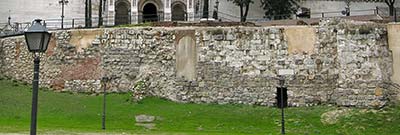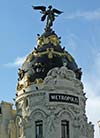|
Europe
> Spain >
Madrid > History &
orientation
Madrid, Spain
Page 2
Continued from page 1

ABOVE: Madrid's 9th Century Muralla Arabe,
or Arab Wall, is next to Almudena Cathedral. It was discovered in 1953 when an
apartment building was torn down. INSET BELOW: Excavations behind the Arab Wall.
Madrid history and orientation
 Origins
and early growth: Madrid is in the center of Spain, on the Castilian
meseta or plain. It was settled by Moors in 852 AD, who built a fortress or
alcázar
to protect Toledo and other Muslim-occupied territories against Christian forces
from the north. They reputedly chose the location because of a stream (the
Manzanares) that offered a plentiful water supply, and the city's current name
of "Madrid" may have derived from an Arab word for "stream" or "source of
water." Origins
and early growth: Madrid is in the center of Spain, on the Castilian
meseta or plain. It was settled by Moors in 852 AD, who built a fortress or
alcázar
to protect Toledo and other Muslim-occupied territories against Christian forces
from the north. They reputedly chose the location because of a stream (the
Manzanares) that offered a plentiful water supply, and the city's current name
of "Madrid" may have derived from an Arab word for "stream" or "source of
water."
 More
than two centuries later, in 1085, Madrid fell into Christian hands, and it
remained a small settlement until Philip II moved his court to Madrid and made
the small city his capital in 1561. Madrid's population grew from some 20,000 to
more than 150,00 over the next century, and the city became the hub of a
powerful and far-flung empire. Spain had its ups and downs in subsequent
centuries, but Madrid continued to grow, and you still can see remnants of
earlier dynasties and construction projects such as the City Hall (1630; see
inset photo), the Plaza Mayor (1590-1790), and the present-day Royal Palace
(1764), which was built after the old and much-expanded Moorish fortress burned
down in 1734. More
than two centuries later, in 1085, Madrid fell into Christian hands, and it
remained a small settlement until Philip II moved his court to Madrid and made
the small city his capital in 1561. Madrid's population grew from some 20,000 to
more than 150,00 over the next century, and the city became the hub of a
powerful and far-flung empire. Spain had its ups and downs in subsequent
centuries, but Madrid continued to grow, and you still can see remnants of
earlier dynasties and construction projects such as the City Hall (1630; see
inset photo), the Plaza Mayor (1590-1790), and the present-day Royal Palace
(1764), which was built after the old and much-expanded Moorish fortress burned
down in 1734.
 Modern
Madrid: Fast-forwarding through the Bourbon, French, Republican,
Nationalist, and other historic periods brings us to the present day, when most of the city that you see
was built in the 19th and 20th Centuries. Along the Gran Vía, for example,
you'll view flamboyant wedding-cake skyscrapers from the early 1900s, leading to
the Plaza de España with its massive, ornately decorated concrete skyscrapers
from the late 1940s and '50s. Modern
Madrid: Fast-forwarding through the Bourbon, French, Republican,
Nationalist, and other historic periods brings us to the present day, when most of the city that you see
was built in the 19th and 20th Centuries. Along the Gran Vía, for example,
you'll view flamboyant wedding-cake skyscrapers from the early 1900s, leading to
the Plaza de España with its massive, ornately decorated concrete skyscrapers
from the late 1940s and '50s.
 Head
north from the center, along the leafy but heavily-trafficked Paseo de la
Castellana, and you'll encounter wildly modern buildings such as the Torres Kio
(left) at the Plaza de Castilla and Terminal 4 at Madrid's Barajas Airport,
which was designed by the Richard Rogers Partnership and Estudio Lamala of
Madrid. The newest precincts of Madrid may not be interesting to the average
tourist, but they're in keeping with the spirit of a dynamic, growing city that
has always been more inclined to look forward than to the past. Head
north from the center, along the leafy but heavily-trafficked Paseo de la
Castellana, and you'll encounter wildly modern buildings such as the Torres Kio
(left) at the Plaza de Castilla and Terminal 4 at Madrid's Barajas Airport,
which was designed by the Richard Rogers Partnership and Estudio Lamala of
Madrid. The newest precincts of Madrid may not be interesting to the average
tourist, but they're in keeping with the spirit of a dynamic, growing city that
has always been more inclined to look forward than to the past.
Next page:
Sightseeing
Torres Kio photo copyright © Duncan Walker..
| |
|